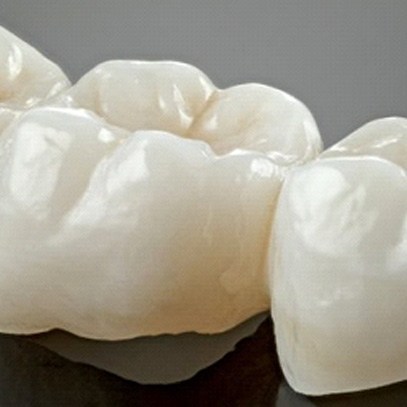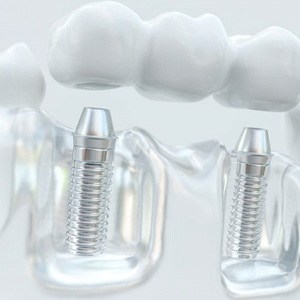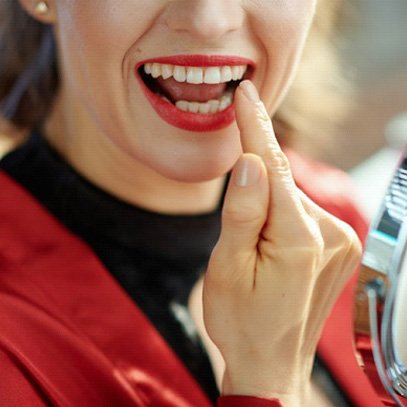Dental Bridges – Garland, TX
Replace Several Teeth with One Beautiful Restoration
Nobody plans to lose teeth, but there are several excellent ways to complete a compromised grin. If you are missing one or several teeth in a row, a dental bridge may be the right way for you to enjoy a complete smile again. At North Garland Family Dental, you can count on Dr. Peterson to bridge that unsightly gap with beautifully lifelike restorations that can prevent oral health issues like dental drift and gum disease. Contact us today to learn more about how restorative dentistry can help you!

Why Choose North Garland Family Dental for Dental Bridges?
- Experienced and Compassionate Dentist
- Beautiful Restorations That Look Like Real Teeth
- Friendly and Courteous Office Environment
What Is a Dental Bridge?

Dental bridges can replace a single missing tooth or several teeth in a row. These alternatives to partial dentures are irremovable because they are held in place by dental crowns attached to healthy teeth or dental implants surgically placed in the jawbone. Each bridge is customized to meet the needs and preferences of each patient, meaning that the crowns are shaped and colored to match their natural smile. This creates a seamless restoration that can improve your chewing ability while helping to maintain your alignment.
Types of Dental Bridges

The first step to getting a dental bridge is having a consultation with Dr. Peterson, during which he will carry out a thorough oral exam, ask you about your goals and preferences, and review your medical history. There are two general types of dental bridges, and the one that is right for you depends on your budget and oral health situation. He may recommend that you receive:
Traditional Dental Bridge

A traditional dental bridge is used to replace either a single tooth or several teeth in a row, and it consists of several artificial teeth strung between two dental crowns. For a traditional bridge to be placed, the patient must have healthy natural teeth on either side of the gap. These teeth will be fitted with beautiful and lifelike dental crowns that hold the bridge in place.
Implant Bridge

An implant bridge works a lot like a traditional bridge except that it is held in place with dental implants placed in the jaw rather than crowns placed on natural teeth. These implants will be placed at either end of a gap in your smile, and they will create a strong and durable hold as they fuse to your jawbone through the natural process of osseointegration. While this process can take some time, dental implants make for the strongest and most stable bridges available.
The Benefits of Getting a Dental Bridge

When you restore your smile with a high-quality dental bridge in Garland, you can rest assured that you will receive a range of amazing benefits that can significantly improve your quality of life, including:
- Restoring your beautiful smile.
- Preventing your existing teeth from shifting out of alignment.
- Protecting teeth from injury by evening out the burden of chewing.
- Bridges can be easily cleaned and maintained.
- Implant bridges prevent bone loss in the jaw.
- Traditional dental bridges can last for fifteen years or more with proper maintenance.
- Dental implants can last for more than thirty-five years, possibly a lifetime, with excellent care.
Dental Bridges FAQs
Is Getting a Dental Bridge Painful?
Before preparing your teeth for a dental bridge, our dentist will apply a local anesthetic to render the process completely painless, and you may also receive sedation treatments if you are especially nervous or anxious. After you receive your dental bridge, you may experience some sensitivity in the treated teeth for a few days. While this can usually be addressed with over-the-counter pain relievers, contact us if the problem worsens. It’s important to remember that a dental bridge can help you avoid future discomfort by preventing the remaining teeth from shifting out of place. If your bridge is supported by implants rather than crowns, you will probably experience some soreness after receiving it, but we’ll provide you with aftercare instructions to ensure comfort and proper healing.
How Many Teeth Can a Dental Bridge Replace?
A dental bridge can be used to replace anywhere from one to four sequential missing teeth, but we usually only recommend using them to replace one or two. Traditional dental bridges become less stable as they get longer, and this is especially problematic if the natural teeth supporting them are not healthy and strong. It’s often risky to use a bridge to replace three or four teeth. Since dental implants are as strong and sturdy as real teeth, implant bridges may be a better option if you have more than two missing teeth in a row.
Do Dental Bridges Feel Natural?
By reshaping the teeth that wear the crowns supporting your bridge and customizing the appliance to fit your mouth, our team ensures that the appliance fits comfortably. In the days after you receive your permanent dental bridge, it should feel increasingly natural as you get used to wearing it. Since bridges are made with durable materials, they can withstand the pressure of everyday chewing like real teeth, making eating while wearing one an easy task. While you may notice a slight difference in texture when you run your tongue across the points of your teeth, you are unlikely to notice any other differences once you are used to wearing your bridge.
Can Dental Bridges Get Cavities?
It’s impossible for a dental bridge to develop cavities, but the natural teeth supporting them still can. Without proper hygiene, food debris can be caught beneath the bridge or between the teeth, allowing harmful oral bacteria that cause oral infections like cavities and gum disease to multiply rapidly. This makes it essential to clean under and around your restoration on a daily basis. It’s also important to remember that an older bridge may begin to separate from the teeth, providing space for bacteria to live and cause infections. If the teeth supporting a bridge become decayed, it may be necessary to remove the restoration so they can be treated.









